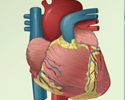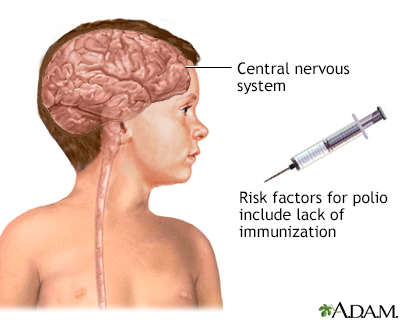Polio
Polio is a viral disease that can affect nerves and can lead to partial or full paralysis. The medical name for polio is poliomyelitis.
Paralysis
Muscle function loss is when a muscle does not work or move normally. The medical term for complete loss of muscle function is paralysis.

Causes
Polio is a disease caused by infection with the poliovirus. The virus spreads by:
- Direct person-to-person contact
- Contact with infected mucus or phlegm from the nose or mouth
- Contact with infected feces
The virus enters through the mouth and nose, multiplies in the throat and intestinal tract, and then is absorbed and spread through the blood and lymph system. The time from being infected with the virus to developing symptoms of disease (incubation) ranges from 5 to 35 days (average 7 to 14 days). Most people do not develop symptoms.
Lymph system
The lymph system is a network of organs, lymph nodes, lymph ducts, and lymph vessels that make and move lymph from tissues to the bloodstream. The l...

Risks factors include:
- Lack of immunization against polio
- Travel to an area that has had a polio outbreak
As a result of a global vaccination campaign over the past 25 years, polio has largely been eliminated. The disease still exists in some countries (such as Pakistan and Afghanistan), with outbreaks occurring in groups of people who have not been vaccinated. For an updated list of these countries, visit the website: www.polioeradication.org.
Symptoms
There are four basic patterns of polio infection:
- Inapparent infection
- Abortive disease
- Nonparalytic
- Paralytic
INAPPARENT INFECTION
Most people infected with poliovirus have inapparent infections. They usually do not have symptoms. The only way to know if someone has the infection is by performing a blood test or other tests to find the virus in the stool or throat.
ABORTIVE DISEASE
People who have abortive disease develop symptoms about 1 to 2 weeks after getting infected with the virus. Symptoms may include:
- Fever for 2 to 3 days
Fever
Fever is the temporary increase in the body's temperature in response to a disease or illness. A child has a fever when the temperature is at or abov...
 ImageRead Article Now Book Mark Article
ImageRead Article Now Book Mark Article - General discomfort or uneasiness (malaise)
Malaise
Malaise is a general feeling of discomfort, illness, or lack of well-being.
 ImageRead Article Now Book Mark Article
ImageRead Article Now Book Mark Article - Headache
- Sore throat
- Vomiting
Vomiting
Nausea is feeling an urge to vomit. It is often called "being sick to your stomach. "Vomiting or throwing-up forces the contents of the stomach up t...
 ImageRead Article Now Book Mark Article
ImageRead Article Now Book Mark Article - Loss of appetite
- Belly pain
These symptoms last up to 5 days and people recover completely. They have no signs of nervous system problems.
Nervous system
The central nervous system is composed of the brain and spinal cord. Your brain and spinal cord serve as the main "processing center" for your entir...

NONPARALYTIC POLIO
People with this form of polio have signs of abortive polio and their symptoms are more intense. Other symptoms may include:
- Stiff and sore muscles at the back of the neck, trunk, arms, and legs
- Urinary problems and constipation
- Changes in muscle reaction (reflexes) as the disease progresses
Reflexes
A reflex is a muscle reaction that happens automatically in response to stimulation. Certain sensations or movements produce specific muscle respons...
 ImageRead Article Now Book Mark Article
ImageRead Article Now Book Mark Article
PARALYTIC POLIO
This form of polio develops in a small percentage of people who are infected with the polio virus. Symptoms include those of abortive and nonparalytic polio. Other symptoms may include:
- Muscle weakness, paralysis, loss of muscle tissue
- Breathing that is weak
- Difficulty swallowing
- Drooling
- Hoarse voice
- Severe constipation and urinary problems
Exams and Tests
During a physical examination, your health care provider may find:
- Abnormal reflexes
- Back stiffness
- Difficulty lifting your head or legs when lying flat on your back
- Stiff neck
- Trouble bending your neck
Tests that may be done include:
- Cultures of throat washings, stools, or spinal fluid
- Spinal tap and examination of the spinal fluid (CSF examination) using polymerase chain reaction (PCR)
CSF examination
Cerebrospinal fluid (CSF) collection is a test to look at the fluid that surrounds the brain and spinal cord. CSF acts as a cushion, protecting the b...
 ImageRead Article Now Book Mark Article
ImageRead Article Now Book Mark Article - Test for levels of antibodies to the polio virus
Antibodies
An antibody is a protein produced by the body's immune system when it detects harmful substances, called antigens. Examples of antigens include micr...
 ImageRead Article Now Book Mark Article
ImageRead Article Now Book Mark Article
Treatment
The goal of treatment is to control symptoms while the infection runs its course. There is no specific treatment for this infection.
People with severe cases may need lifesaving measures, such as help with breathing.
Symptoms are treated based on how severe they are. Treatment may include:
- Antibiotics for urinary tract infections
Urinary tract infections
A urinary tract infection, or UTI, is an infection of the urinary tract. The infection can occur at different points in the urinary tract, including...
 ImageRead Article Now Book Mark Article
ImageRead Article Now Book Mark Article - Moist heat (heating pads, warm towels) to reduce muscle pain and spasms
- Painkillers to reduce headache, muscle pain, and spasms (narcotics are not usually given because they increase the risk of breathing trouble)
- Physical therapy, braces or corrective shoes, or orthopedic surgery to help recover muscle strength and function
Outlook (Prognosis)
The outlook depends on the form of the disease and the body area affected. Most of the time, complete recovery is likely if the spinal cord and brain are not involved.
Brain or spinal cord involvement is a medical emergency that may result in paralysis or death (usually from breathing problems).
Breathing
The words "respiratory" and "respiration" refer to the lungs and breathing.

Disability is more common than death. Infection that is located high in the spinal cord or in the brain increases the risk of breathing problems.
Possible Complications
Health problems that may result from polio include:
- Aspiration pneumonia
Aspiration pneumonia
Pneumonia is inflammation (swelling) and infection of the lungs or large airways. Aspiration pneumonia occurs when food or liquid is breathed into th...
 ImageRead Article Now Book Mark Article
ImageRead Article Now Book Mark Article - Cor pulmonale (a form of heart failure found on the right side of the circulation system)
Cor pulmonale
Cor pulmonale is a condition that causes the right side of the heart to fail. Long-term high blood pressure in the pulmonary arteries of the lung an...
 ImageRead Article Now Book Mark Article
ImageRead Article Now Book Mark Article - Lack of movement
- Lung problems
- Myocarditis (inflammation of the heart muscle)
Myocarditis
Myocarditis is inflammation of the heart muscle. The condition is called pediatric myocarditis when it occurs in children.
 ImageRead Article Now Book Mark Article
ImageRead Article Now Book Mark Article - Paralytic ileus (loss of intestinal function)
Paralytic ileus
Intestinal obstruction is a partial or complete blockage of the bowel. The contents of the intestine cannot pass through it.
 ImageRead Article Now Book Mark Article
ImageRead Article Now Book Mark Article - Permanent muscle paralysis, disability, deformity
- Pulmonary edema (abnormal buildup of fluid in the lungs)
Pulmonary edema
Pulmonary edema is an abnormal buildup of fluid in the lungs. This buildup of fluid leads to shortness of breath.
 ImageRead Article Now Book Mark Article
ImageRead Article Now Book Mark Article - Shock
Shock
Shock is a life-threatening condition that occurs when the body is not getting enough blood flow. Lack of blood flow means the cells and organs do n...
 ImageRead Article Now Book Mark Article
ImageRead Article Now Book Mark Article - Urinary tract infections
Post-polio syndrome is a complication that develops in some people, usually 30 or more years after they are first infected. Muscles that were already weak may get weaker. Weakness may also develop in muscles that were not affected before.
When to Contact a Medical Professional
Contact your provider if:
- Someone close to you has developed poliomyelitis and you haven't been vaccinated.
- You develop symptoms of poliomyelitis.
- Your child's polio immunization (vaccine) is not up to date.
Prevention
Polio immunization (vaccine) prevents poliomyelitis in most people (over 90% effective).
Vaccine
All content below is taken in its entirety from the CDC Polio Vaccine Information Statement (VIS): www. cdc. gov/vaccines/hcp/current-vis/polio. html...

Reviewed By
Jatin M. Vyas, MD, PhD, Associate Professor in Medicine, Harvard Medical School; Associate in Medicine, Division of Infectious Disease, Department of Medicine, Massachusetts General Hospital, Boston, MA. Also reviewed by David C. Dugdale, MD, Medical Director, Brenda Conaway, Editorial Director, and the A.D.A.M. Editorial team.
Jorgensen S, Lau M, Arnold WD. Motor neuron diseases. In: Cifu DX, ed. Braddom's Physical Medicine & Rehabilitation. 6th ed. Philadelphia, PA: Elsevier; 2021:chap 40.
Romero JR. Poliovirus. In: Bennett JE, Dolin R, Blaser MJ, eds. Mandell, Douglas, and Bennett's Principles and Practice of Infectious Diseases. 9th ed. Philadelphia, PA: Elsevier; 2020:chap 171.
Simões EAF. Polioviruses. In: Kliegman RM, St. Geme JW, Blum NJ, Shah SS, Tasker RC, Wilson KM, eds. Nelson Textbook of Pediatrics. 21st ed. Philadelphia, PA: Elsevier; 2020:chap 276.

 All rights reserved.
All rights reserved.